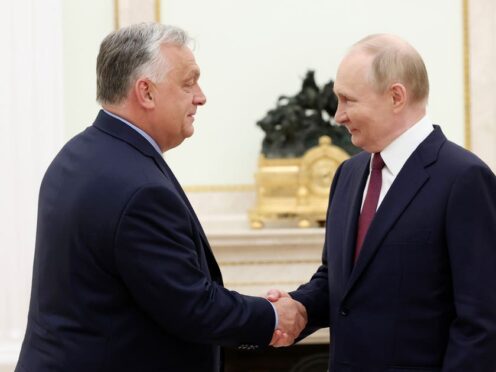
Hungarian Prime Minister Viktor Orban visited Moscow to discuss prospects for a peaceful settlement in Ukraine with Russian President Vladimir Putin – a rare trip to Russia by a European leader that drew condemnation from Kyiv and European leaders.
Mr Orban’s visit comes only days after he made a similar unannounced trip to Ukraine, where he met with President Volodymyr Zelensky and proposed that Ukraine consider agreeing to an immediate ceasefire with Russia.
“The number of countries that can talk to both warring sides is diminishing,” Mr Orban said.

“Hungary is slowly becoming the only country in Europe that can speak to everyone.”
Hungary assumed the rotating presidency of the EU at the start of July and Putin suggested that Mr Orban had come to Moscow as a top representative of the European Council.
Several top European officials dismissed that suggestion and said Mr Orban had no mandate for anything beyond a discussion about bilateral relations.
The Hungarian prime minister, widely seen as having the warmest relations with Mr Putin among EU leaders, has routinely blocked, delayed or watered down EU efforts to assist Kyiv and impose sanctions on Moscow for its actions in Ukraine.
He has long argued for a cessation of hostilities in Ukraine but without outlining what that might mean for the country’s territorial integrity or future security.
That posture has frustrated Hungary’s EU and Nato allies, which have broadly considered Russia’s actions as a breach of international law and a threat to the security of countries in Eastern Europe.
After Mr Putin and Mr Orban met, Russian presidential aide Yuri Ushakov said they had a “frank conversation” on all issues relating to Ukraine.
Ukraine’s Foreign Ministry said in a statement that Mr Orban’s decision to visit Moscow was made “without approval or coordination” with Kyiv.

It added that “the principle of “no agreements on Ukraine without Ukraine remains inviolable for our country” and called on all states to strictly adhere to it.
Mr Putin’s spokesperson, Dmitry Peskov, said the visit to Moscow was Mr Orban’s idea and was only agreed to on Wednesday, according to the Russian state news agency Tass.
Mr Peskov added that Moscow valued Mr Orban’s ”strong, clear and consistent course” aimed at trying to resolve the conflict.
Mr Putin told Mr Orban that he wanted to hear about the position of his “European colleagues” on Ukraine and discuss Moscow’s plan for peace as well as bilateral relations.
Mr Orban noted that the meeting was the fourteenth time the leaders have held bilateral talks since 2009.
European officials and leaders have heavily criticised Mr Orban’s visit to Moscow, something only one other European leader has done since the start of the conflict.
“This is about appeasement. It’s not about peace,” European Commission spokesperson Eric Mamer said.
Hungary at the beginning of the month took over the six-month rotating presidency of the EU Council, a largely formal role that can be used to shape the bloc’s policy agenda.

Mr Orban has said he wants to use the presidency to advocate for an end to the fighting in Ukraine.
The EU’s foreign policy chief, Josep Borrell, said in a statement that Mr Orban’s visit to Moscow “takes place, exclusively, in the framework of the bilateral relations between Hungary and Russia”.
“Prime Minister Orban has not received any mandate from the EU Council to visit Moscow,” Mr Borrell said, adding that his “position excludes official contacts between the EU and President Putin. The Hungarian Prime Minister is thus not representing the EU in any form”.
He noted that Putin has been indicted by the International Criminal Court and an arrest warrant released for his role in relation to the forced deportation of children from Ukraine to Russia.
Nato Secretary-General Jens Stoltenberg said Mr Orban informed him in advance about his travel to Moscow but that he “is not representing Nato at these meetings”.
In an email on Friday, Mr Orban’s press chief, Bertalan Havasi, said the Hungarian leader’s trip comes “as part of his peace mission” — reflecting the image of a peacemaker that the populist leader has cultivated since Mr Putin sent his troops into Ukraine in February 2022.
Hungarian Foreign Minister Peter Szijjarto also joined the trip to Moscow, according to a post on his Facebook page.
Speaking to Hungarian state radio before departing Friday morning, Mr Orban said he was aware that his country’s presidency of the EU “does not entitle us to negotiate on behalf of anyone”.
Without mentioning reports of his planned trip to Moscow, he said his trip earlier this week to Kyiv did not “need a mandate, because I do not represent anything”.
“The only thing I do is go to those places where there is a war or the threat of war that has negative consequences for Europe and Hungary as well,” he added.
Other EU officials have expressed dismay that Mr Orban undertook the trip unilaterally and without the approval of the bloc’s member states.
European Council President Charles Michel on Thursday said on the social media platform X that “the EU rotating presidency has no mandate to engage with Russia on behalf of the EU”.
“The European Council is clear: Russia is the aggressor, Ukraine is the victim. No discussions about Ukraine can take place without Ukraine,” Mr Michel wrote.
Mr Orban is the first European leader to visit Russia and sit down for talks with Mr Putin since Austrian Chancellor Karl Nehammer visited Moscow in April 2022, just weeks after he ordered his troops into Ukraine.
During that visit he said he raised the issue of crimes allegedly committed in Ukraine by Russian forces.

Enjoy the convenience of having The Sunday Post delivered as a digital ePaper straight to your smartphone, tablet or computer.
Subscribe for only £5.49 a month and enjoy all the benefits of the printed paper as a digital replica.
Subscribe